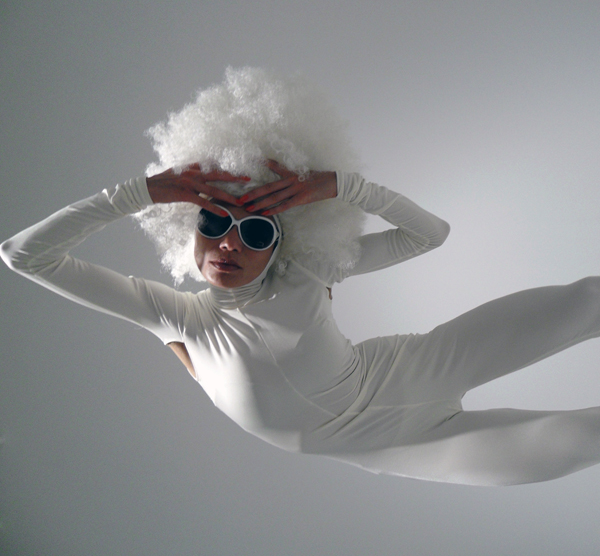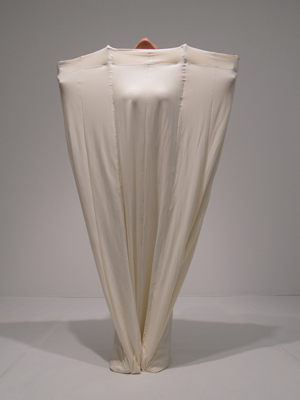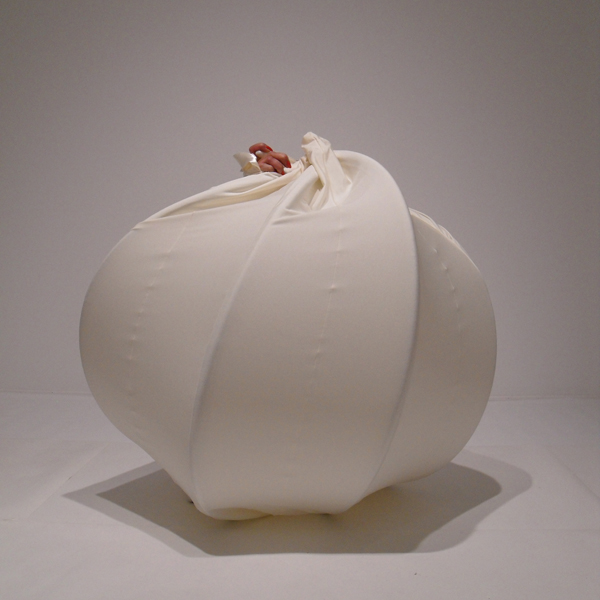-
Lilibeth Cuenca Rasmussen at Sculpture Center
by Lauren DiGiulio November 19, 2009

Lilibeth Cuenca Rasmussen’s The present doesn’t exist in my mind, and the future is already far behind, presented last Saturday at the University Settlement as part of Performa 09, explores the influences of early Futurist poetry on the artist’s contemporary voice, creating a cross-generational dialogue investigating to what extent today’s feminism can take influence from the Futurists.
The performance consists of Rasmussen’s physical interpretation of seven poems, written by the early modernist poet Mina Loy, and by the artist herself. Loy’s words underscore the work with rich symbolic imagery, while Rasmussen’s sharper tone brightens and provokes. By bringing these distinct voices together in dialogue, Rasmussen celebrates the influence of Futurism on her work while using it as a point of reference to orient herself within the landscape of feminist performance.
The work takes the form of a spoken word jam fest in which the artist’s lyric storytelling guides the audience through a non-narrative journey rife with sensual poetic imagery and feminist self-assertion. Standing alone onstage, Rasmussen explores various embodiments of these poems through vocal and choreographic interpretation. Original music composed by Pete Drungle and Brian Bender, who create eerie dissonance with piano, drums, and guitar, imbues the performance with theatrical effect. The incorporation of video projection, depicting abstract geometrical patterns that meander behind the artist onstage, adds a pleasingly meditative visual element that further frames the work within a Futurist aesthetic.
Throughout the first four poems, Rasmussen inhabits a large white modular costume that bends to create a variety of geometric shapes, alternating exposing and hiding the form of her body according to its mode of employ. During her interpretation of Mina Loy’s She-He-We, a sensual poem exploring points of intersection between masculine and feminine entities, she molds the costume into an egg-like structure that hides her body. For Surfing the Surface, her own poem about the role of self-empowerment within digital culture’s disembodied space, she pushes her body against the fabric of the costume to emphasize its form.

Later, she completely breaks free of its confines, shedding the costume to reveal a white spandex jumpsuit beneath. She dons a white Afro wig and sunglasses to perform her poem Fuck the F Word. Here, she takes influence from Futurist ideology to reject the use of the term “feminism” and assert the need for a newly imagined identity, proclaiming “Fuck the F, relight the fire/Let the granny feminist retire/Feminism suffers, because of a name/This gotta change, we can attain!” She calls upon women to “Make a promise to never get tame/Be a daredevil and don’t be ashame.”
After speaking a Mina Loy poem that explores the ambivalence of Loy’s feelings about motherhood, Rasmussen ends the performance with her own Artist Song, a poem that renounces the political structure of the contemporary art world. Here, she claims Futurism as an inspiration and rejects the influence of art historical context in an effort to move forward, declaring “Futurism useful for my access/In their spirit, I must detach to progress/Art was never made to last/Cut off nostalgic strings to the past.”

By investing in a reanimated Futurism, Rasmussen detaches herself from previous aesthetic and cultural influence, and asserts the need for new order. Yet such detachment is more easily asserted than achieved. A scratch along the surface of the work reveals deep feminist influences that run the gamut of the movement. Most notable is her corporeal appropriation of écriture féminine, illustrated in the form of her embodied textual performances. Her direct addresses to women also place her work solidly within the realm of identity-centered politics, with a sprinkling of radical feminist overtones garnishing the text. For all its calls to revolution, her work remains embedded within the very influences she denounces, and could offer more in the way of forward-thinking alternatives.
The piece would perhaps be more effective if both Rasmussen’s text and body were slightly more compelling in performance. The poetry’s adherence to a strict AABB rhyme scheme quickly grows tiresome, confining the language to a set of formal aesthetic regulations that undermine her empowered message. In addition, her delivery of the text is often difficult to understand above the atmospheric music. Furthermore, by confining herself to the center of the stage for the duration of the performance Rasmussen prevents her body from fully expressing her text’s meaning. While the work ultimately offers a playful interpretation of early Futurist poetry, some of Rasmussen’s more radical assertions don’t quite hold up.
Lilibeth Cuenca Rasmussen’s “The present doesn’t exist in my mind, and the future is already far behind”, presented by SculptureCenter and supported by the Danish Arts Council, was performed at University Settlement on November 7 in association with Performa.


1 Comment
Art21 Bloggers’ Top Tens of 2009 and the 2000s | Art21 Blog
[...] Lilibeth Cuenca Rasmussen’s performance, The Present Doesn’t Mind and the Future is Already Far … [...]